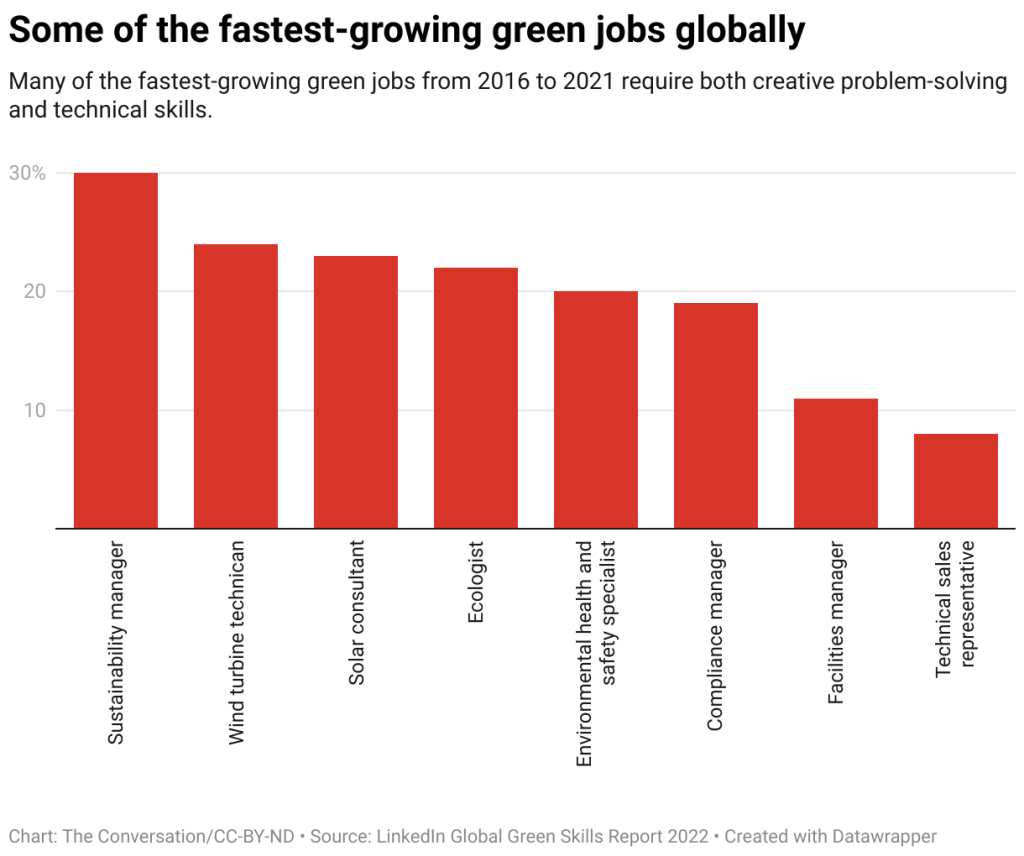
Written by: Christopher Boone & Karen C. Seto
To meet today’s global sustainability challenges, the corporate world needs more than a few chief sustainability officers – it needs an army of employees, in all areas of business, thinking about sustainability in their decisions every day.
That means product designers, supply managers, economists, scientists, architects and many others with the knowledge to both recognize unsustainable practices and find ways to improve sustainability for the overall health of their companies and the planet.
Employers are increasingly looking for those skills. We analyzed job ads from a global database and found a tenfold increase in the number of jobs with “sustainability” in the title over the last decade, reaching 177,000 in 2021.
What’s troubling is that there are not enough skilled workers to meet the rapid growth in green and sustainability jobs available.
While the number of “green jobs” grew globally at a rate of 8 percent per year over the last five years, the number of people listing green skills in their profiles only grew by 6 percent per year, according to a LinkedIn analysis of its nearly 800 million users.

As professors who train future workers in sustainability principles and techniques, we see several effective ways for people at all stages of their careers to gain those skills and increase those numbers.
Where sustainability jobs are growing fastest
In the U.S., jobs in the renewable energy and environment sectors, grew by 237 percent over the last five years. Globally, the transition from fossil fuels to renewable energy is forecast to result in a net increase in jobs for the energy sector.
But green jobs go well beyond solar panel installation and wind turbine maintenance.
Sustainable fashion is one of the fastest-growing green jobs sectors, averaging a 90 percent growth rate annually between 2016 and 2020.
The rapid expansion of ESG investing – environment, social and governance – and portfolio management is opening up new jobs in sustainable finance. In 2021, the accounting firm PwC announced that it would invest US$12 billion and create 100,000 new jobs in ESG investing by 2026.

There is also a growing demand for urban sustainability officers who can help transition cities to be net-zero carbon and more resilient. After all, the world is adding 1 million people to cities every five days and building 20,000 American football fields’ worth of urban areas someplace on the planet every day.
In 2013, when the Rockefeller Foundation launched 100 Resilient Cities, a network to help cities become more sustainable, few cities had a resilience or sustainability officer. Today, more than 250 communities and 1,000 local government professionals are part of the Urban Sustainability Directors Network.
The number of companies with chief sustainability officers in executive positions also tripled from 9 percent to 28 percent between 2016 and 2021. But given the scale and business opportunities of sustainability, these skills are needed much more widely within organizations.
So, where can you find training?
Most sustainability and green jobs require creative problem-solving, synthesizing and technical skills. Some of those skills can be learned on the job, but boosting the number of qualified job applicants will require more effective and accessible training opportunities that target employers’ needs. Here are a some training sources to consider.
University programs: Sustainability is increasingly being incorporated into a wide range of university programs. Fifteen years ago, sustainability training was mostly ad hoc – a product designer or economist might have taken a class in sustainability approaches from the environmental science department. Today, U.S. universities have about 3,000 programs with a “sustainability” label, up from 13 in 2008.
A National Academies report recommends looking for a competency-based approach to sustainability learning that blends content with skills and links knowledge to action to solve problems and develop solutions.
Micro-credentials: For mid-career employees who don’t have the time to reinvest in full-fledged degrees, short courses and micro-credentials offered by universities, colleges or professional groups offer one way to develop sustainability skills.
A micro-credential might involve taking a series of courses or workshops focused on a specific skill, such as in wind energy technology or how to incorporate ESG criteria into business operations.
Short courses and micro credentials take up less time and are much less expensive than college degree programs. That may also help lower-income individuals train for sustainability jobs and diversify the field.
Specializations: A similar option is jobs-focused online certificate programs with a sustainability specialization.
For example, Google teamed up with universities to provide online courses for project managers, and Arizona State University is offering a sustainability specialization to accompany it. Project management is an area where the U.S. Department of Labor expects to see fast job growth, with 100,000 job openings in the next decade.
Corporate training: Some companies have developed their own internal sustainability training in climate science, sustainable finance, sustainability reporting and other skills.
Integrating sustainability across all functions of companies will require some level of sustainability training and understanding for most if not all employees. Companies like Starbucks, HSBC, Salesforce and Microsoft have created internal training programs to spread sustainability knowledge and practice throughout their companies, not just for employees who have sustainability in their titles.
Closing the gap
A recent survey by Microsoft and BCG of major companies found that only 43 percent of sustainability professionals in businesses had sustainability-related degrees, and 68 percent of sustainability leaders were hired internally.
It’s clear that on-the-job sustainability training and up-skilling will be necessary to fill the growing number of roles inside of companies.
To meet the sustainability skills gap, we believe more training will be required – at colleges and universities, by professional organizations and from employers. Achieving global sustainability and meeting climate change challenges will become more likely as legions of people commit their working hours to sustainability solutions.
Header Image Credit: Andy DeLisle/ASU







